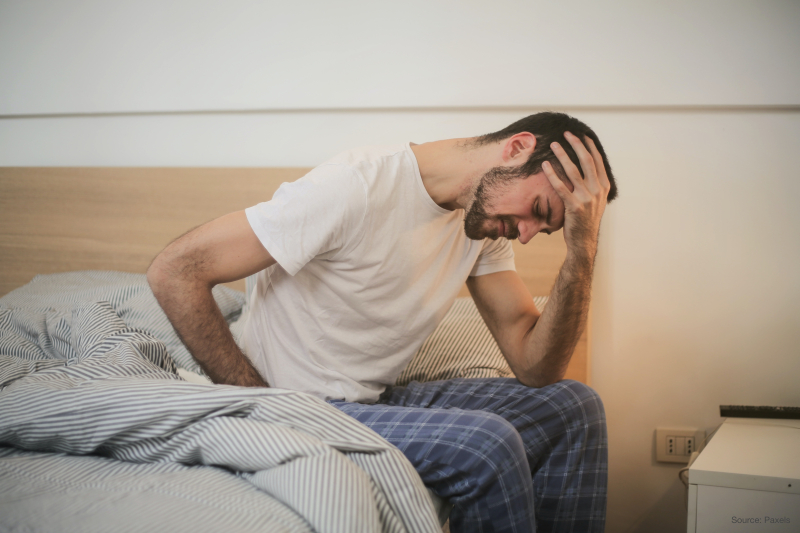Erectile dysfunction manifests as difficulties in achieving or maintaining an erection sufficient for sexual intercourse. An erection is a state when the erectile tissues of the penis fill with blood, causing the penis to enlarge, harden, and become erect. If blood is not pumped into the penis adequately or under sufficient pressure, an erection may not occur or may only occur to an insufficient degree.
Symptoms of erectile dysfunction:
In youth, erections may occur even without sexual stimuli. It seems as if the penis has a mind of its own and practices erection even in the most nonsensical situations, including writing mathematical papers. However, sexual stimulation is usually required to achieve an erection.
For a young, healthy man, the slightest stimulus is sufficient – a glance at a beautiful woman, the scent of a woman, a light touch with a dance partner, or just a memory of pleasant moments together. A little is enough, and tightness begins in the pants.
As age progresses and testosterone levels decrease, which occurs around the age of 40, insufficient or absent erections become a common problem, even with sexual stimulation. For more information on the correlation between testosterone levels and erectile dysfunction, see the article Erectile Dysfunction and Testosterone.
When does the problem with erections start, and when do we talk about failure?
1. Difficulty achieving an erection
Occasional failure of erection can occur even in an otherwise healthy man. The cause may not be an illness or physical difficulty right away; mental discomfort (work stress, argument with a partner, loss of a favourite team) may suffice. And suddenly it doesn't work.
If it's an isolated experience, there's no need to worry. That happens occasionally. If the failure occurs more frequently, whether with a partner or during masturbation, it's time to address the problem.
2. Difficulty maintaining an erection
Sometimes an erection occurs, but the penis becomes flaccid during sex. The inflow and outflow of blood to and from the penis during one sexual encounter are normal and common.
Anything from external disturbances to memories of an unfinished task may be to blame. Likewise, clumsy manipulation of the penis by the partner can evoke unpleasant feelings and lead to deflation.
If a man wants to continue sexual activity and if the penis reawakens during stimulation, everything is fine. If the penis loses its erection during sexual stimulation without the man experiencing any previous discomfort, it's likely that there's a problem that needs to be addressed.
3. Decreased sexual desire
Occasionally not having the desire for sex is common – a person may be sleep-deprived, tired, feeling under pressure, having a cold, or otherwise uncomfortable. The problem arises when sexual desire occurs much less frequently than before.
The question is whether decreased sexual desire (libido) bothers men. Some men lose their sexual appetite without being bothered by this change. And there are men who have a harder time with reduced sexual energy and do not want to accept the current state.
To allow desire to rise again, it's necessary to find the cause of the problem. This is often long-term stress or anything that the body or mind struggles with, leaving them with no capacity for sexual desire. By identifying and eliminating the cause, sexual desire can be increased again.
Only those who don't try to find a solution truly fail.
Sex brings many benefits to life. It's good for the heart, immunity, stress relief, improves sleep, burns calories, delays aging, boosts confidence, and strengthens the relationship between partners. Therefore, erectile dysfunction and decreased sexual desire need to be addressed. Only those who don't try to find a solution truly fail. Sexual health is a treasure that needs to be protected.
IMPORTANT! Almost all forms of erectile dysfunction can occur in men of any age — not only in older men but also in young and even adolescent men.
You might also be interested in: Erectile Dysfunction at 20 or Erectile Problems at 60.
Can Erectile Dysfunction be Treated? Of course, yes. The choice of treatment method depends on the underlying causes of the problem. These can include primarily positive lifestyle changes (e.g., quitting smoking, increased physical activity), prostate massage, concurrent treatment of underlying conditions that may have led to ED, consultations with a psychotherapist/sexologist (in the case of psychogenic dysfunction), local administration of vasoactive substances, and the prescription of certain oral medications — particularly Phosphodiesterase Type 5 Inhibitors (PDE-5).
If there are no contraindications, tablets containing the active ingredient Sildenafil (generic Viagra) are widely used. Our customers recommend:
- Cenforce Series — Cenforce 100, Cenforce 150, or Cenforce 200 (manufactured by Centurion Laboratories Pvt. Ltd.);
- Kamagra Tablets — some of the best Viagras on the market. Our range includes Kamagra Effervescent Tablets, Kamagra Chewable, Kamagra 100mg Gold, Kamagra Jelly, or Kamagra Original (manufactured by Ajanta Pharma Ltd.);
- Cobra 120 mg, Kingmaster, and Sildalist (these medications are just as effective and available at the lowest price in our eShop).
In addition, other products, such as those containing Tadalafil (generic Cialis), are frequently used to treat erectile dysfunction. You should consider products such as:
- Apcalis Oral Jelly, Tadalis 20mg, or Tadarise (they offer long-lasting effects of up to 36 hours);
- Vidalista Series — we offer Vidalista 20, Vidalista 40, Vidalista 60, and Vidalista CT.
There are also products on the market that combine the active ingredients sildenafil and dapoxetine (a substance used to treat premature ejaculation):
Or Dapoxetine combined with Tadalafil, as in the product Tadapox.
Final Note
Overall, it’s important to remember that an insufficient erection is, of course, not ideal, but in most cases, it is very much treatable — and quite quickly and at a reasonable price. The key is not to pretend that the problem does not exist, as such an approach would only lead to a worsening of the issue.
You might also be interested in: Problems with Erection and Stamina or Impotence.
Author: Jason Smith







